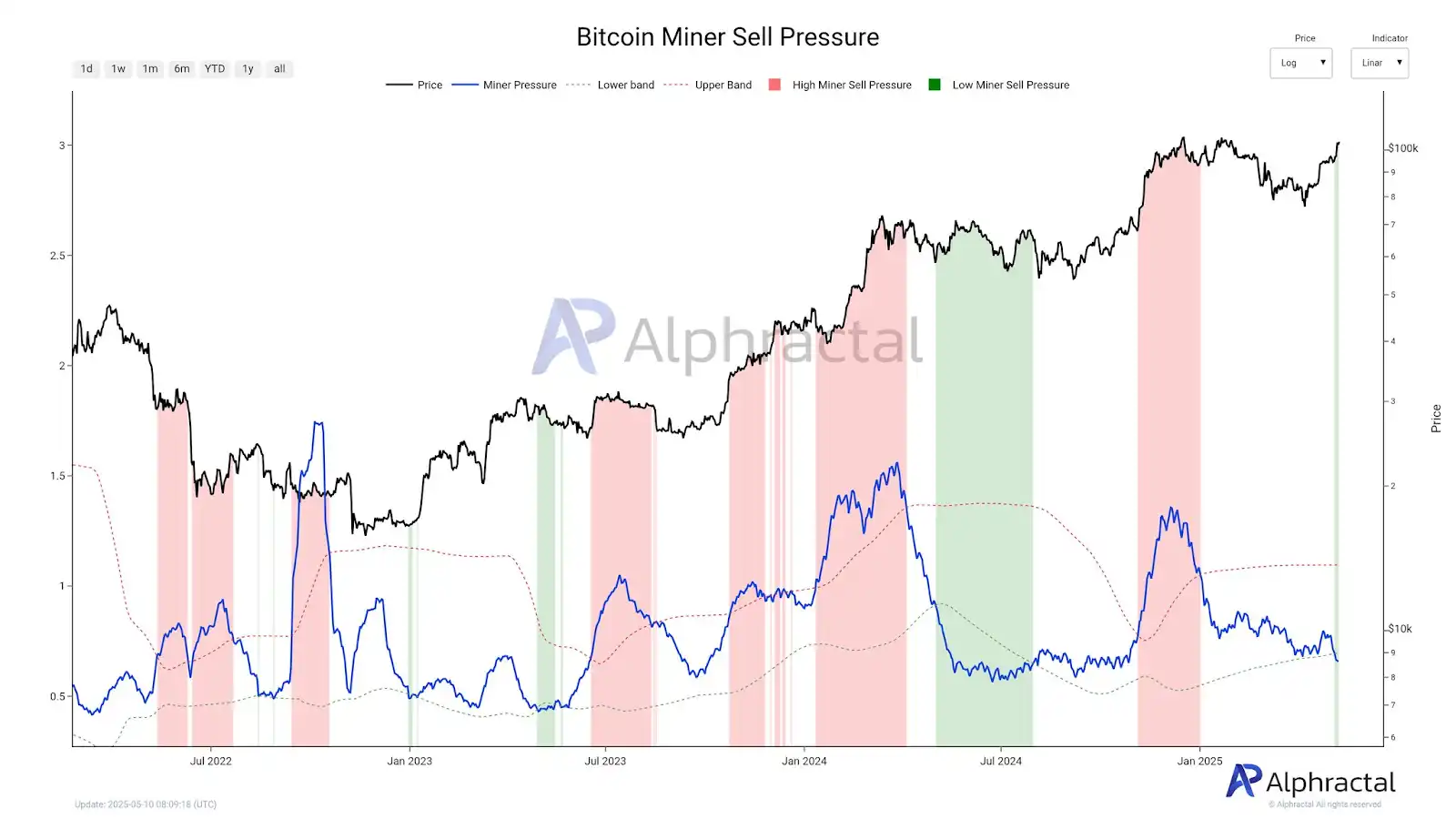Original Title: "Is $100,000 Just the Starting Point? Miner Holdings Hit Cycle Low + US-China Tariff Exemptions, Bitcoin Enters Frenzy Mode"
Original Author: Lawrence, Mars Finance
First Part: Bitcoin Miners' Selling Pressure Drops to Lowest Level Since 2024—Is the Market Gearing Up for New Highs?
1. Shift in Miner Behavior: From Selling to Holding

According to the latest data from cryptocurrency analysis platform Alphractal, the Bitcoin miner selling pressure indicator (which measures the ratio of outflows to reserves over a 30-day period) has fallen below the lower bound, reaching its lowest level since 2024. This phenomenon indicates that miners are shifting from the past model of "selling to cover operational costs" to a more strategic accumulation.
This contrasts sharply with the predicament of miners' income being halved after the 2024 halving (when daily selling volume increased from 900 to 1200 BTC), but the current changes in the market environment have prompted miners to adjust their strategies:
· Profit Expectations Drive Accumulation: With Bitcoin's price recently breaking $100,000 and approaching historical highs, miners are more inclined to hold Bitcoin in anticipation of higher returns rather than cashing out in the short term.
· Structural Optimization in the Industry: The large-scale development of mining led by publicly listed companies (such as Bitfarms and CleanSpark) has reduced the exit risk for inefficient miners, and the increased industry concentration has alleviated selling pressure.
· Learning from Historical Experience: In past cycles, excessive leverage and long-term holding by miners led to liquidity crises (such as the 2018 bear market), and there is now a greater focus on short-term financial stability.
2. On-Chain Data Reveals Market Resilience
Alphractal's miner selling pressure indicator shows that the current market structure is vastly different from the "panic selling" seen at the beginning of 2024:
· Long-Term Holders Dominate: Currently, over 80% of Bitcoin is held for more than 6 months, significantly lower than the dominance of short-term holders at historical cycle peaks, providing stable support for prices.
· Exchange Reserves at New Lows: The reserves of Bitcoin on exchanges continue to decline, indicating that the market is in a "high-speed accumulation phase," with selling pressure dispersed through over-the-counter trading or institutional holdings.
· Derivatives Market Risks: Although the spot market remains stable, there are a large number of highly leveraged long positions in the $100,000 to $110,000 range, which could trigger a multi-billion dollar liquidation wave if prices fluctuate.
3. Price Trends and Future Expectations
As of May 12, 2025, the price of Bitcoin is reported at $104,250, with a 24-hour increase of 1% and a cumulative increase of over 30% in the past month. The market's focus on future trends is divided on the following points:
· Technical Signals: The RSI (75) indicates overbought conditions, but the MACD continues to rise; if the key support level of $100,000 is breached, it may trigger selling from short-term holders.
· Impact of Macroeconomic Variables: Expectations of interest rate cuts by the Federal Reserve (if cuts exceed 100 basis points in 2025) could provide Bitcoin with a "Davis Double" opportunity, but stagflation risks may weaken its safe-haven attributes.
· Dynamics of Miner Behavior: If the price breaks above $110,000, miner selling pressure may rise, but the current low selling levels suggest the market may enter a "calm upward phase."
Second Part: Market Concerns Behind "Substantial Progress" in US-China Trade Agreement
1. White House Statement and Agreement Outline

On May 11, US Treasury Secretary Scott Basset and Trade Representative Jamison Greer jointly announced that the US-China trade negotiations have made "substantial progress," with both sides reaching a principled consensus in the following areas:
· Market Access: China has committed to expanding imports of US agricultural products, and the extension of tariff exemptions on certain US technology products.
· Intellectual Property Protection: Establishing a cross-border enforcement cooperation mechanism to lower barriers to technology transfer.
· Dispute Resolution Mechanism: Setting up a permanent consultation platform to prevent the escalation of trade frictions.
2. Market Reaction and Concerns
Despite the positive signals from officials, the lack of details in the agreement has led investors to be cautiously optimistic:
· Residual Uncertainty: The volatility of Trump administration policies (such as the "one-day" tariff exemption in 2024) has weakened market trust, and risk assets remain under pressure until the agreement is finalized.
· Unresolved Structural Contradictions: Competitive policies between the US and China in areas such as semiconductors and artificial intelligence (like "Trade War 2.0") may continue through non-tariff means.
· Diverging Liquidity Effects: If the agreement leads to a decline in the US Dollar Index (DXY), Bitcoin may benefit from a renewed "anti-fiat" narrative; however, if negotiations break down and trigger safe-haven demand, gold may divert funds.
3. Global Economic Ripple Effects
The potential systemic impacts of easing US-China trade tensions include:
· Supply Chain Restructuring: The agreement may accelerate the trend of "nearshoring," enhancing the manufacturing hubs in Mexico and Southeast Asia, and increasing demand for cross-border cryptocurrency payments.
· Inflation Relief Expectations: Tariff reductions are expected to alleviate pressure on the US CPI, providing room for the Federal Reserve to cut rates, indirectly benefiting risk assets.
· Geopolitical Risk Shifts: If US-China cooperation strengthens, alternative crises such as the Russia-Ukraine conflict and Middle East tensions may become new sources of market volatility.
Third Part: Market Game and Investment Strategies Intertwined with Dual Main Lines
1. Resonance Between Bitcoin and Macroeconomic Policies
· Interest Rate Sensitivity and Correlation: The correlation between Bitcoin and the Nasdaq Index (0.78) indicates that it has not yet detached from the traditional risk asset framework; if the US-China trade agreement boosts tech stocks, Bitcoin may benefit in tandem.
· Miner Behavior as a Leading Indicator: Historical data shows that after miner selling pressure bottoms out, Bitcoin often enters an upward cycle (such as the bull market following miner capitulation in 2023), and the current low selling levels may indicate a similar trend.
2. Risk and Opportunity Assessment
· Short-Term Volatility Risks: The accumulation of leverage in Bitcoin derivatives and the unclear details of the US-China agreement may trigger price fluctuations, with the support level of $100,000 becoming a dividing line for bulls and bears.
· Strengthening Long-Term Narrative: The average daily accumulation of Bitcoin ETFs (800 BTC) remains higher than miner output (450 BTC), and the institutionalization process mitigates some market shocks.
Conclusion: Certainty Logic in a Complex Market
The global market in May 2025 stands at the dual juncture of Bitcoin's "post-halving cycle" and the "rebalancing of US-China trade relations." The low selling pressure from miners and the progress of the White House agreement may seem independent, but they point to a core proposition: asset repricing under liquidity reconstruction. Whether Bitcoin breaks previous highs or the US-China agreement materializes, the market will ultimately validate a truth—amid the collision of macroeconomic iron curtains and crypto narratives, only assets that combine resilience and efficiency can achieve long-term victory.
免责声明:本文章仅代表作者个人观点,不代表本平台的立场和观点。本文章仅供信息分享,不构成对任何人的任何投资建议。用户与作者之间的任何争议,与本平台无关。如网页中刊载的文章或图片涉及侵权,请提供相关的权利证明和身份证明发送邮件到support@aicoin.com,本平台相关工作人员将会进行核查。




